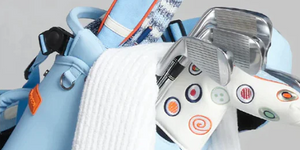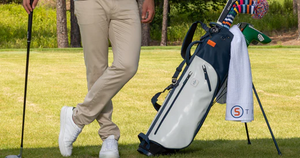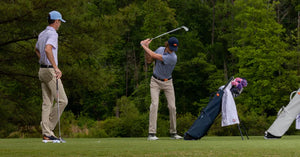Why Do Golf Clubs Have Numbers?
Do you ever struggle to know which club to pull from your bag at the right time?
Learning golf can initially feel complicated; we've all been there before when stepping up to put and seeing several clubs with different numbers on the clubheads. Which one do you use to make your shot?
If you're new to golf, you may be confused about all the numbers and letters on the club. But once you understand the golf club numbers, you’ll realize it’s not just a simple system to understand—it can also help you decide which clubs to use for the perfect shot.
Keep reading to learn why golf clubs have numbers, what they mean, and when to use each numbered club.
What Are the Golf Club Numbers?
You look into your golf bag and see various numbers: Does it matter whether you choose between #2 iron and #7 iron?
The numbers on the clubhead tell you the loft, i.e., the angle of your clubface. The loft affects the height of your shot. The higher the golf club number, the steeper the angle.
Also, the higher the loft, the higher the flight height, the more open the clubface, and the less carry and distance it'll have. Conversely, a lower number means the ball will have a low flight trajectory with more distance.
Not all clubs have numbers on them. Only the wood and irons have them. Woods are the bigger clubs and hit the ball further. In contrast, irons are compact and used for better precision.
The rest of the non-numbered clubs serve specific purposes. For example, drivers are for your first hit, while putters are for the green.
Numbered Golf Clubs
The different numbered golfed clubs are:
- - 3-wood
- - 5-wood
- - 1-iron
- - 2-iron
- - 3-iron
- - 4-iron
- - 5-iron
- - 6-iron
- - 7-iron
- - 8-iron
- - 9-iron
Non-Numbered Golf Clubs
Since you typically hold one of each non-numbered golf club in a bag, there's no need to differentiate them by loft angles like you would with the woods and irons.
The various non-numbered golf clubs include:
- - Driver
- - Putter
- - Lob Wedge
- - Sand Wedge
- - Pitching Wedge
What Do the Numbers on Golf Clubs Mean?
As mentioned, the club numbers represent the clubface's angle. The angle affects how far and high your shots go.
The loft in a #3 wood typically ranges from 15 to 18 degrees in loft angle. A #5 wood loft ranges from 20 to 22 degrees, and the #7 and #9 wood can have up to 24 degrees.
Due to their long shaft, #1 through #3 irons are called long irons and have a loft between 20 to 25 degrees. The #4 through #6 irons have a loft between 25 to 30 degrees. The #7 through #9 short irons can range from 35 to 41 degrees.
Lower-numbered clubs are more useful if you struggle to get enough distance. However, you'll want to hit higher shots as you improve your game.
That's because launching the ball high up in the air has advantages when it lands on the green. It'll stop more quickly and get closer to the hole. Lower-flight paths won't stop easily, especially on slick surfaces. The flight trajectory will significantly impact your score.
These numbers are on the clubface, so you can see them when your clubs are in the bag. Even covers have these numbers marked.
What Are the Different Numbered Golf Clubs For?
There isn't a hard-and-fast rule for club selection and distance. Playing styles vary depending on your swing and the feel of each club. However, we've put together guidelines to help you get started.
Based on the distance from the hole, you can select the following clubs:
- - Driver: 230 or more yards
- - #3-wood: 210 yards
- - #2-iron and #4-wood: 190 yards
- - #3-iron and #5-wood: 180 yards
- - Irons
- - #4: 170 yards
- - #5: 160 yards
- - #6: 150 yards
- - #7: 140 yards
- - #8: 130 yards
- - #9: 120 yards
- - Wedges
- - Pitching: 110 yards
- - Sand: 90 yards
- - Lob: 65 yards
- - Putter: On the green
While you must abide by the USGA rules for length, dimension, and weight, you can use any of the 14 golf clubs in your bag for any shot.
You can drastically improve your game by choosing clubs geared towards beginners. We recommend first learning how to use the #7 and #8 irons. They are user-friendly and offer an outstanding balance of loft in the club face. Many beginners use these irons for shots outside the green.
Besides the distance, you can also choose your club based on where you are on the course. Here are common club selections made based on the situation presented:
Tee Box:
- - Driver
- - Fairway Wood
- - Hybrid
- - Iron
- - Fairway
Fairway:
- - Fairway Wood
- - Hybrid
- - Iron
- - Wedge
On the Rough:
- - Iron
- - Hybrid
- - #7 or #9 Fairway Wood
- - Wedge
Around the Green:
- - #8 or #9 Iron
- - Wedges
- - Putter
On the Green:
- - Putter
Golf club selection is more of an art than science. Someone like Tiger can hit about 200 to 250 yards with the #2 and #4 irons. For you, perhaps that's less.
The most important thing is to play it safe by choosing the club that fits your needs, including your skill level and handicap. Take these suggestions as guidelines and experiment with what works for you.
Conclusion
It's important to try the different numbered clubs and see which ones feel most comfortable to you, based on the situation.
Now you're ready to take what you've learned and excel on the golf course! And while you’re working toward playing like a pro, check out STITCH golf apparel, club head covers, golf bags, and more so that you can look the part of a pro.


